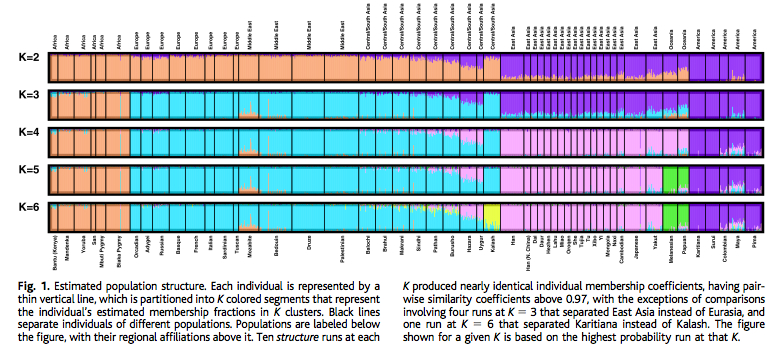Admixture: An Amerindian Component in Eurasian Populations
About a year ago, one of genome bloggers, Diogenes, discovered, using ADMIXTURE, an intriguing “Amerindian” component in a wide range of East and West Eurasian populations. Here are the results of his ADMIXTURE runs.
Grey represents the component that’s modal in Amerindians. But it doesn’t occur only in Amerindians. It’s found elsewhere. Plus it doesn’t occur only in the adjacent parts of Siberia. It occurs at decreasing frequencies from Inuits and Paleoasiatic peoples in the northeast to Slovenians, French and Lezgins in the southwest. One of the commenters, Charles Nydorf, suggested a hypothesis similar to the out-of-America family of models: “There is a considerable amount of American Indian gray that gets into Asia. Usually this kind of thing is said to be the result of the Asian origin of American Indians but I’m wondering about another possibility: Could a demographic expansion from South and Middle America have led to the diffusion of some genes back into Asia?” First of all, it repeats, almost word-to-word, the hypothesis I advanced back in the mid-1990s in a Russian paper entitled “The kinship systems of Siberian peoples and the problem of a Paleo-Siberian substrate”, on the basis of the comparison between Amerindian and Siberian kinship systems, to explain the origin of what ethnologists call a “Paleosiberian substrate” in Eurasia. Second of all, it jibes well with the phylogeny of the variants of a major pan-Eurasian and North American mythological motif called “Earth-Diver” as outlined by Vladimir Napolskikh, a linguist who conducted an extensive deep-dive into the distribution of this motif. In his Habilitation Doctorate dissertation entitled “The Earliest Stages in the Evolution of the Peoples of the Uralic Linguistic Stock: Evidence from Mythological Reconstruction” (1992), Napolskikh positioned North American Indian versions of the motif as more divergent and archaic than the Eurasian versions.
Another genome blogger over at Eurogenes Genetic Ancestry Project echoes Diogenes finding: “The above two plots show that Baltic Finns carry sequences that are most similar to those of Amerindian populations, and not because of a lack of reference samples from across Siberia. These sequences don’t appear to be all that unusual in my Finnish samples. What this means is that we’re not just looking at noise here, but genuine links between Finns and Amerindians.”
This discovery has stimulated some discussion in other blogger circles. Razib wrote: “Genome blogger Diogenes has been harping on the possibility that a low level substratum component among Northern Europeans which has affinities to Siberians and Amerindians may be a remnant of the original European hunter-gatherers. It follows then that these groups were later marginalized and absorbed by waves of farmers coming from the Middle East and south-central Eurasia.” It reminded him of Stanford and Bradley’s Solutrean hypothesis but his own interpretation was around “a set of post-Gravettian societies spanned the northern fringe of Eurasia, and that one branch went east to populate North America.” He recently returned to the Solutrean hypothesis, again disapprovingly, but with an eye to a possible interpretation of Joseph Pickrell’s phylogenetic tree adjusted for gene flow as supporting the Amerindian-Siberian substrate in European populations.
An Amerindian component in Eurasia shouldn’t be “big news” for those who carefully read mainstream genetic publications. Back in 2002, Noah Rosenberg et al. published “Genetic Structure of Human Populations.” It was the first application of STRUCTURE analysis to human genome data. I remember it was previewed by Marcus Feldman at one of genetics seminars at Stanford. Its Fig. 1 shows the same picture.
What’s striking about this STRUCTURE plot is that the purple component (modal in Amerindians all the way on the right) stretches all the way to the left and is found at K=2 throughout the world, including Africa.





[…] HGDP set. American Indians are back in. The ADMIXTURE plot replicates the finding of a pervasive Amerindian component in Eurasia and shows that it extends all the way to African Yoruba, a population that’s considered […]